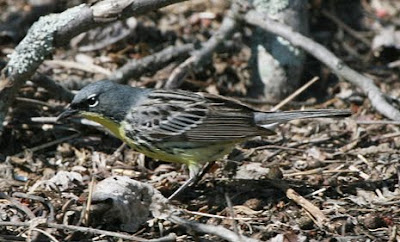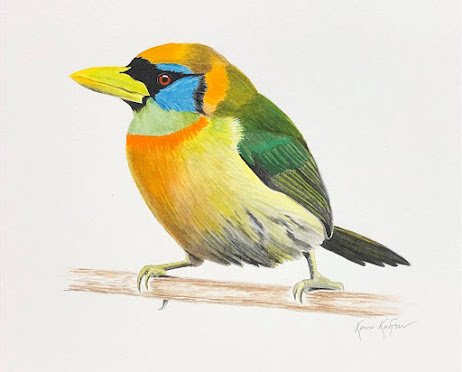Special K
 Kirtland's Warbler: the rarest songbird in North America
Kirtland's Warbler: the rarest songbird in North AmericaFrom Oak Harbor, Ohio, Kenn writes: In my previous post on May 30, I mentioned that I'd been making predictions for the migration throughout the Biggest Week In American Birding: checking to see what birds were around, watching the weather reports, trying to predict which days would have the biggest arrivals of migrants. For the first 8 days of the event, this was an exercise in mild frustration, because the weather patterns just weren’t lining up to produce any major migrant wave. We were seeing excellent diversity of migrants -- and the guides from Tropical Birding were making sure that everyone on the scene got to see a lot of different species. But the kind of day that we dream about in northwest Ohio, with migrants everywhere, the trees filled to bursting with warblers and others, just had not happened yet as late as Thursday, May 13.
Based on the weather forecasts, I had been predicting for days that Friday, May 14, was going to be a big day. There’s a certain amount of pressure involved in making predictions like this, especially if people take you seriously! I knew from conversations with birders that many people were planning days off from work, or playing hooky from school, based on my predictions, so I was really sweating it at dawn on May 14th. No matter how closely you study the weather forecasts, it’s always possible that the wind will shift unexpectedly and the predicted big day will turn out to be a dud. But as soon as I arrived out at the Wildlife Beach at Magee Marsh, just after sunrise on May 14, I could tell that this was a great day. Birds were everywhere. The place was swarming with catbirds, orioles, Least Flycatchers, and more than a dozen species of warblers. Silent flocks of Blue Jays were streaming overhead, while thrushes bounced around in the thickets. Anyone who came out on this day would not be disappointed.
I knew that the guides from Tropical Birding (and hundreds of other birders) would be concentrated at the Magee Marsh boardwalk, so I decided to work east along the Wildlife Beach to see what I could find there. I’d been birding the thickets and low trees of this area for a couple of hours, and was just about to turn around and head elsewhere, when I spotted a bird moving across an opening far ahead of me. Superficially it looked like a Palm Warbler, with tail-bobbing habit and all; and I had been seeing a lot of Palm Warblers out there. But something about the bird looked odd. I walked on up to double-check on it.
When I got to the spot, there was a Palm Warbler perched up in a low willow, and at first it seemed that must have been what I saw. But then I froze when I heard a distinctive birdsong from the thickets. A warbler song, but low-pitched and choppy and emphatic for a warbler.
Oh, yeah. Special K.
Kirtland’s Warbler is one of the rarest birds in North America. It was very close to extinction in the 1970s and 1980s, when its population dipped below 350 individuals. Thanks to a lot of hard work by dedicated conservationists, its population is now up over 3000, but that’s still a terrifyingly low number for a songbird. Kirtland’s Warbler nests mainly in a few counties in Michigan and winters in the Bahamas, and extremely few are seen in migration. Our area of northwest Ohio is the best place in the world to see migrating Kirtland’s, but even here the species is not seen every year. Some birders have been coming here for many years without ever seeing one.
But there was a Kirtland’s Warbler singing from the thicket in front of me, and there were hundreds of birders, maybe thousands, within a couple of miles of where I stood, because this was the Biggest Week In American Birding. And because it was the Biggest Week, we had made arrangements to get the word out quickly about rarities. I pulled the iPhone out of my pocket and quickly composed one of the short little notes that is fancifully called a "Tweet" in the service called "Twitter." I just tapped in this note:
"Kirtlands on Magee east beach 300 yards east of parking lot Kenn K"
And then I called Kimberly, who was, of course, at the Black Swamp Bird Observatory, the center of the action for the big birding week. At the registration tables at BSBO, we had a giant screen set up to display the Twitter updates, and as Kim answered the phone, my note about the Kirtland’s Warbler popped up on the screen.
If I’d had any doubts earlier about the value of using Twitter for the Biggest Week, those doubts evaporated as the word went out about the Kirtland’s. Out on the Magee boardwalk, out on the trails at Ottawa National Wildlife Refuge, over at the shorebird sites on Stange Road, cell phones beeped and birders read the text message about the rare warbler. Word of mouth spread rapidly from a hundred separate points. I had been all alone on the beach, but within minutes, a stream of birders began arriving.

Ever since I had heard the warbler sing I had been hanging back, staying well away so I wouldn’t risk scaring it before the birders arrived. But as the crowd began to gather, it became apparent that the bird was utterly unconcerned about our presence. It hopped about in the low sumacs and willows, sometimes disappearing into dense growth for a minute but more often coming out to hop on the sand in the open. As the birders gathered, a hundred or two hundred or more at a time in a wide semicircle on the beach, the Kirtland’s Warbler continued to perform like the superstar that it was.


At any moment, the Kirtland’s could have flown a hundred yards south into a closed section of the wildlife area, and it never would have been seen again. But it stayed, and stayed, out in the open. From the time I sent out my "tweet" about the bird at 9:17 a.m. until I finally left after 1:30 p.m., the bird was seldom out of sight, and my best guesstimate was that more than a thousand people came and had great looks at it. Other bloggers who stayed later in the afternoon estimated that more than three thousand people saw the bird! It was so obliging, often moving toward its admiring audience, that even people with little point-and-shoot cameras were able to take pictures, while more serious photographers filled up whole memory cards. Indeed, I suspect that this individual became the most-photographed Kirtland’s Warbler in history.

Swamped with visiting crowds at the Black Swamp Bird Observatory, Kimberly didn’t get out to see this individual; at the only times when she could have gotten away, she stayed to mind the observatory so others could dash back to the beach and see the bird. Of course, Kimberly has seen several Kirtland’s in this area in past years, starting before I ever moved to Ohio, so she was able to visualize the scene and vicariously share in the excitement. This Kirtland’s stayed the entire day, so that people arriving that evening were able to go out to the beach after 7 p.m. and see it. The following morning it was nowhere to be found; so it was a one-day wonder, as migrants often are. But for that one day, that one bird provided tremendous excitement for a lot of happy birders.



Congratulations, Kenn, from one of the ten people in America that didn't see the Kirtland's Warbler!
ReplyDelete:)
Jerry
Thank you Kenn!
ReplyDeleteWe were on the Kellys Island trip when we heard the news...that was a very long boat ride!
We brought along Sam and Christian and watching Christian running as fast as he could was a great sight!
I was not there that day but had a similar experience on 5-21. As our group drove up to the Magee Marsh parking lot we got the word from the part of the group who had arrived early that there was a Kirtlands Warbler on the beach. U turn away from the boardwalk and off to the beach we went. At first we could not find it but then a guy down the way was beckoning. There was the Kirtlands Warbler, tame as a park pigeon and in no hurry to leave. What a joy. I learned never to leave my camera behind.
ReplyDeleteYour tale of how the warbler was found is as thrilling as seeing the bird itself must have been (pure conjecture since I'd left Oak Harbor days earlier!) This is like one of those Big Fish stories where the fish doesn't get away. Thanks for sharing it.
ReplyDeletenice!
ReplyDelete